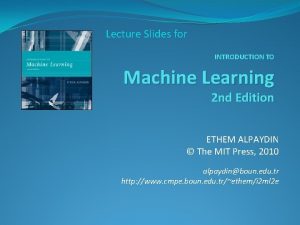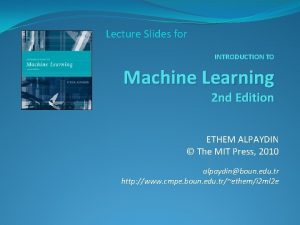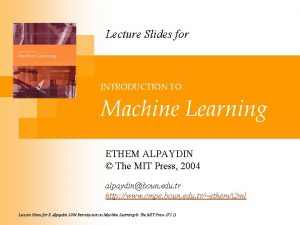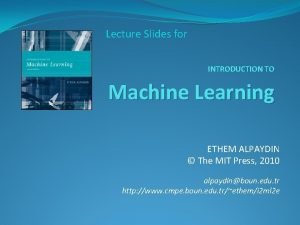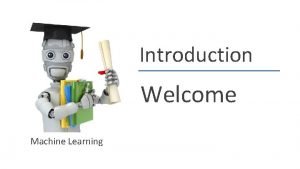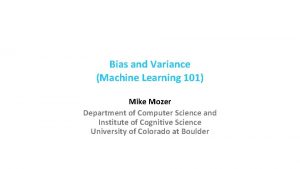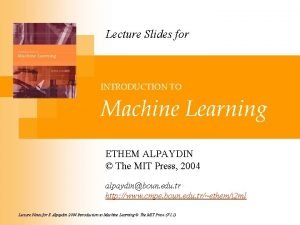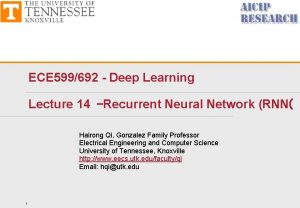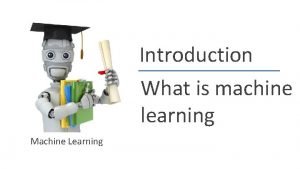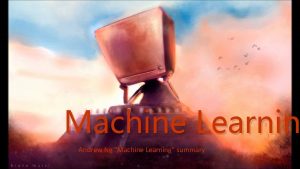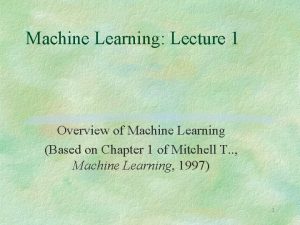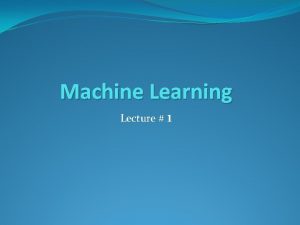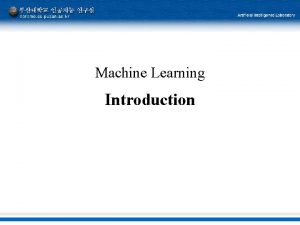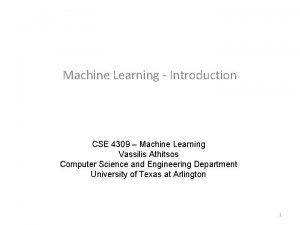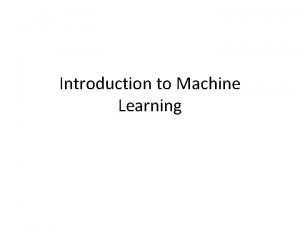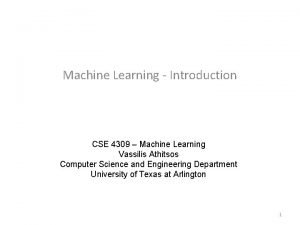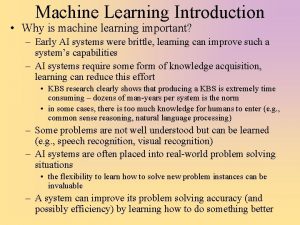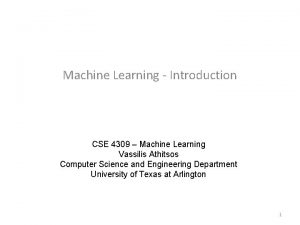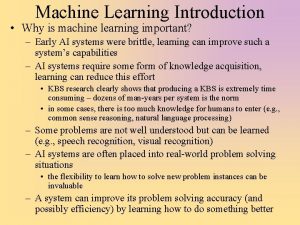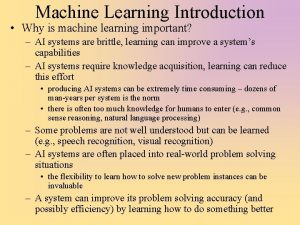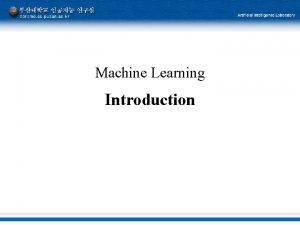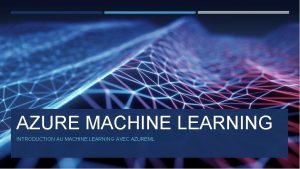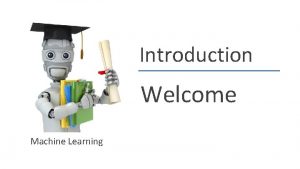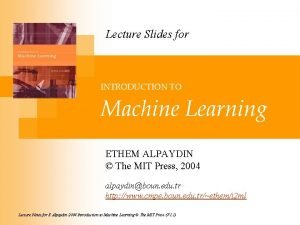Lecture Slides for INTRODUCTION TO Machine Learning 2



























- Slides: 27

Lecture Slides for INTRODUCTION TO Machine Learning 2 nd Edition ETHEM ALPAYDIN © The MIT Press, 2010 alpaydin@boun. edu. tr http: //www. cmpe. boun. edu. tr/~ethem/i 2 ml 2 e

CHAPTER 7: Clustering

Semiparametric Density Estimation �Parametric: Assume a single model for p(x|Ci) (Chapter 4 and 5) �Semiparametric: p(x|Ci) is a mixture of densities Multiple possible explanations/prototypes: Different handwriting styles, accents in speech �Nonparametric: No model; data speaks for itself (Chapter 8) Lecture Notes for E Alpaydın 2010 Introduction to Machine Learning 2 e © The MIT Press (V 1. 0) 3

Mixture Densities where Gi : the mixture components/groups/clusters P(Gi) : mixture proportions (priors) p(x|Gi) : component densities Gaussian mixture where p(x|Gi) ~ N ( μi , ∑i ) parameters Φ = {P(Gi ), μi , ∑i }ki=1 unlabeled sample X={xt}Nt=1 (unsupervised learning) Lecture Notes for E Alpaydın 2010 Introduction to Machine Learning 2 e © The MIT Press (V 1. 0) 4

Classes vs. Clusters Supervised: X = { xt , rt }t Classes Ci , i =1, . . . , K Unsupervised : X = { xt }t Clusters Gi , i =1, . . . , k where p(x|Ci)~N (μi, ∑i ) where p(x|Gi)~N (μi, ∑i) Φ = {P(Ci ), μi , ∑i }Ki=1 Φ = {P(Gi ), μi , ∑i }ki=1 Labels, r ti ? Lecture Notes for E Alpaydın 2010 Introduction to Machine Learning 2 e © The MIT Press (V 1. 0) 5

k-Means Clustering �Find k reference vectors (prototypes/codebook vectors/ codewords) which best represent data �Reference vectors, mj, j =1, . . . , k �Use nearest (most similar) reference: �Reconstruction error Lecture Notes for E Alpaydın 2010 Introduction to Machine Learning 2 e © The MIT Press (V 1. 0) 6

Lecture Notes for E Alpaydın 2010 Introduction to Machine Learning 2 e © The MIT Press (V 1. 0) 7

k-means Clustering Lecture Notes for E Alpaydın 2010 Introduction to Machine Learning 2 e © The MIT Press (V 1. 0) 8

k-means Clustering � One disadvantage: � A local search procedure � The final mi highly depend on the initial mi � The methods to initial mi � Randomly select k instances � Calculate the mean of all data and add small random vectors � Calculate the principal component partitioning the data into k groups, and then take the means of these groups Lecture Notes for E Alpaydın 2010 Introduction to Machine Learning 2 e © The MIT Press (V 1. 0) 9

Encoding/Decoding Lecture Notes for E Alpaydın 2010 Introduction to Machine Learning 2 e © The MIT Press (V 1. 0) 10

11 Expectation-Maximization Algorithm • An expectation-maximization (EM) algorithm is used in statistics for finding maximum likelihood estimates of parameters in probabilistic models, where the model depends on unobserved latent variables. • EM is an iterative method which alternates between performing an expectation (E) step, ▫ which computes an expectation of the log likelihood with respect to the current estimate of the distribution for the latent variables, and a maximization (M) step, ▫ which computes the parameters which maximize the expected log likelihood found on the E step. (http: //en. wikipedia. org/wiki/Expectation-maximization_algorithm)

Expectation-Maximization (EM) � Log likelihood with a mixture model � Assume hidden variables z, which when known, make optimization much simpler � Complete likelihood, Lc(Φ |X, Z), in terms of x and z � Incomplete likelihood, L(Φ |X), in terms of x Lecture Notes for E Alpaydın 2010 Introduction to Machine Learning 2 e © The MIT Press (V 1. 0) 12

E- and M-steps � Iterate the two steps 1. E-step: Estimate the expectation of the log likelihood given X and current Φ 2. M-step: Find new Φ’ given z, X, and old Φ. An increase in Q increases incomplete likelihood (proven by Laird and Rubin (1977)) Lecture Notes for E Alpaydın 2010 Introduction to Machine Learning 2 e © The MIT Press (V 1. 0) 13

EM in Gaussian Mixtures �Define indicator variables zt ={zt 1 , zt 2 , …, ztk } zti = 1 if xt belongs to Gi, 0 otherwise; assume p(x|Gi)~N(μi, ∑i) �z is the multinomial distribution from k categories with prior probabilities πi. �E-step: (See p. 169 - p. 170) where Lecture Notes for E Alpaydın 2010 Introduction to Machine Learning 2 e © The MIT Press (V 1. 0) 14

EM in Gaussian Mixtures �M-step: assume p(x|Gi)~N(mi, Si), the M-step is (see p. 170) Use estimated labels in place of unknown labels Lecture Notes for E Alpaydın 2010 Introduction to Machine Learning 2 e © The MIT Press (V 1. 0) 15

EM in Gaussian Mixtures �E-step: Lecture Notes for E Alpaydın 2010 Introduction to Machine Learning 2 e © The MIT Press (V 1. 0) 16

P(Gi|x)=hi=0. 5 Data points and the fitted Gaussians by EM, initialized by one k-means iteration of Figure 7. 2. Unlike in k-means, EM allows estimating the covariance matrices. hi indicates the contours of the estimated Gaussian densities. Lecture Notes for E Alpaydın 2010 Introduction to Machine Learning 2 e © The MIT Press (V 1. 0) 17

Discussion � If the input dimensionality is high and the sample is small, to decrease the number of parameters: � Assuming a common covariance matrix may not be right since clusters may really have different shapes. � Assuming diagonal matrices is even more risky because it removes all correlations. � The alternative is to do dimensionality reduction in the clusters. � Use PCA/FA to decrease dimensionality. (Ghahramani and Hinton, 1997; Tipping and Bishop, 1999) � For example, in mixtures of FA use EM to learn Vi. Vi and specific variances of cluster are the factor loadings and. Lecture Notes for E Alpaydın 2010 Introduction to Machine Learning 2 e © The MIT Press (V 1. 0) 18

Supervised Learning after Clustering �Dimensionality reduction methods find correlations between variables and thus group variables. �Clustering methods find similarities between instances and thus group instances. �Allows knowledge extraction through number of clusters, prior probabilities, cluster parameters, i. e. , center, range of features. Example: customer segmentation Lecture Notes for E Alpaydın 2010 Introduction to Machine Learning 2 e © The MIT Press (V 1. 0) 19

Mixture of Mixtures �In classification, the input comes from a mixture of classes (supervised). �If each class is also a mixture, e. g. , of Gaussians, (unsupervised), we have a mixture of mixtures: Lecture Notes for E Alpaydın 2010 Introduction to Machine Learning 2 e © The MIT Press (V 1. 0) 20

Hierarchical Clustering �Cluster based on similarities/distances �Distance measure between instances xr and xs Minkowski distance (Lp) (Euclidean for p = 2) City-block distance Lecture Notes for E Alpaydın 2010 Introduction to Machine Learning 2 e © The MIT Press (V 1. 0) 21

Agglomerative(會凝聚的) Clustering �Start with N groups each with one instance and merge two closest groups at each iteration �Distance between two groups Gi and Gj: �Single-link clustering: �Complete-link clustering: �Average-link clustering, centroid Lecture Notes for E Alpaydın 2010 Introduction to Machine Learning 2 e © The MIT Press (V 1. 0) 22

Example: Single-Link Clustering Dendrogram(樹狀圖) Lecture Notes for E Alpaydın 2010 Introduction to Machine Learning 2 e © The MIT Press (V 1. 0) 23

http: //mirlab. org/jang/books/dcpr/dc. Hier. Clustering. asp? title=32%20 Hierarchical%20 Clustering%20(%B 6%A 5%BCh%A 6%A 1%A 4%C 0%B 8 s%AAk)&language=chinese Lecture Notes for E Alpaydın 2010 Introduction to Machine Learning 2 e © The MIT Press (V 1. 0) 24


Choosing k (the number of clusters) �Defined by the application �e. g. , image quantization �Plot data (after PCA) and check for clusters �Incremental (leader-cluster) algorithm �Add one at a time until “elbow” (reconstruction error/log likelihood/intergroup distances) �Manual check for meaning Lecture Notes for E Alpaydın 2010 Introduction to Machine Learning 2 e © The MIT Press (V 1. 0) 26

Exercises �What are the similarities and difference between average-link clustering and k-means? �How can we make k-means robust to outliers? Lecture Notes for E Alpaydın 2010 Introduction to Machine Learning 2 e © The MIT Press (V 1. 0) 27
 Machine learning lecture slides
Machine learning lecture slides Introduction to machine learning slides
Introduction to machine learning slides Machine learning lecture notes
Machine learning lecture notes Machine learning lecture notes
Machine learning lecture notes A small child slides down the four frictionless slides
A small child slides down the four frictionless slides A spring loaded gun shoots a plastic ball
A spring loaded gun shoots a plastic ball Principles of economics powerpoint lecture slides
Principles of economics powerpoint lecture slides Business communication lecture slides
Business communication lecture slides 01:640:244 lecture notes - lecture 15: plat, idah, farad
01:640:244 lecture notes - lecture 15: plat, idah, farad Concept learning task in machine learning
Concept learning task in machine learning Analytical learning in machine learning
Analytical learning in machine learning Pac learning model in machine learning
Pac learning model in machine learning Pac learning model in machine learning
Pac learning model in machine learning Inductive and analytical learning in machine learning
Inductive and analytical learning in machine learning Focl in machine learning
Focl in machine learning Instance based learning in machine learning
Instance based learning in machine learning Inductive learning machine learning
Inductive learning machine learning First order rule learning in machine learning
First order rule learning in machine learning Eager learning vs lazy learning
Eager learning vs lazy learning Deep learning vs machine learning
Deep learning vs machine learning Introduction to machine learning ethem alpaydin
Introduction to machine learning ethem alpaydin Andrew ng intro machine learning
Andrew ng intro machine learning Introduction to machine learning andrew ng
Introduction to machine learning andrew ng Mike mozer
Mike mozer Introduction to machine learning ethem alpaydin
Introduction to machine learning ethem alpaydin Introduction to machine learning and data mining
Introduction to machine learning and data mining Lstm lecture
Lstm lecture Introduction to machine learning andrew ng
Introduction to machine learning andrew ng

